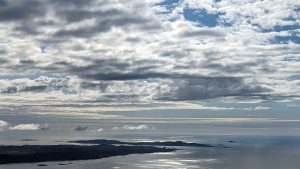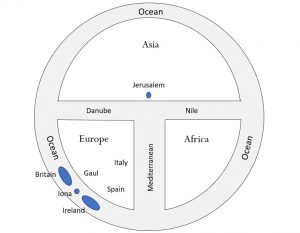Earlier this month I was on Mull with my family, and happened to climb up the magnificent hill called Bearraich at the west end of Ardmeanach (the ‘middle peninsula’ on the west side of three-pronged Mull). We were actually looking for the extremely rare tiny plant called Iceland purslane. We found it too, but that’s another story.
What struck me as I stood on the summit of Bearraich, however, was this view looking south-west. The tip of the Ross of Mull points westward, and just beyond it a thin line of rock which is the island of Iona. And stretching beyond that the vastness of sky and ocean.

One doesn’t get such a dramatic impression normally, on arriving at Iona by bus and ferry. But this view from Bearraich reminded me forcefully of the words of the abbot of Iona describing his own island in the seventh century: ‘this small and uttermost island of the Brittanic ocean’.[1] In Adomnán’s mental map, Iona is at the very edge of the world.
Thomas O’Loughlin has done a lot of work on the shape of Adomnán’s world. In his book Adomnán and the Holy Places (London, 2007) he explores the literature available to a seventh-century Irish monk (authors such Augustine, Ambrose, Jerome, Isidore) to show just how much ‘on the edge’ Iona was seen to be. There were three continents: Asia in the east, Europe in the north-west and Africa in the south-west. These three continents were separated by bodies of water: the Mediterranean Sea, the Danube (or perhaps the Don) and the Nile.[2] There were other less significant rivers of course, and other small seas, but these were the principal structures of geography. And the whole of this world is surrounded by Oceanus – the Ocean – the great gathered body of water separated from the dry land in Genesis 1:9. The waters of the inland rivers and seas flowed into and out of the Ocean, but it remained as the great ‘beyond’. This medieval vision of the world expressed itself in a presentation called the T-O map – not because those are the initials of Thomas O’Loughlin, but because it looks like a letter T inside the great O of the ocean.

The medieval map of the world as envisaged in Isidore’s Etymologiae
(based on Thomas O’Loughlin, Adomnán and the Holy Places (London, 2007), 144-59.
In this way of mapping the world we can see just how much ‘on the edge’ Iona was, along with Britain and Ireland. This explains why Patrick, in the fifth century, saw his mission in Ireland as having such huge significance. He believed he was living in ‘the last days’ (novissimis diebus) of history:
… so that I should imitate those whom the Lord once foretold would preach his Gospel as a testimony to all nations before the end of the world; and so we have seen, and so it has been fulfilled. Behold we are witnesses that the Gospel is preached to the point where beyond it there is no-one.[3]
In this world-view, shaped by classical and biblical authorities, Ocean is the name for the monstrous and often demonic space beyond the known world. The world populated by human beings is a world of order and language and place-names, but it is surrounded by the threat of Ocean. Out there, on the waves, there are few if any place-names. There Columba’s monks encounter ‘a prodigious monster’ (monstruoso … prodigio), a ‘great whale’ (cetus magnus) which threatens them. Some monks survive by fleeing, while another survives by his simple faith: ‘I and that beast are in God’s hand,’ he says, and blesses the sea and the whale.[4] Another monk seeks ‘a desert in the Ocean’(in oceano desertum), but fails to find what he is looking for. Eventually, indeed, on a third attempt in the Ocean, he finds himself driven far to the north by the wind and is surrounded by ‘loathsome and exceedingly dangerous smalll creatures covering the sea .. which struck with terrible impact the bottom and sides, the stern and the prow … They were about the size of frogs, very injurious by reason of their stings.’ It is only by the powerful prayers of Columba who was ‘present in spirit’ in Cormac’s ship, while actually on Iona praying with his community, that Cormac survived and reached his own monastery again in safety.[5] At another time Columba is sitting on top of a hill – probably Dún Í – and sees a plague-bearing cloud arising from the sea in the north (i.e. in an even more remote part of Ocean), threatening the lives of people and beasts in Ard Ceannachte. All are delivered from death by being sprinkled with water made holy by Columba’s blessing.[6]
In all these stories the Ocean is a place of conflict: the holy monks, by their prayers and their faith, are in struggle with the chaotic and demonic forces which dwell among the endless waves. It is all rather reminiscent of the Egyptian desert in Athanasius’s Life of Antony which is the theatre of that saint’s conflict with demons.
We are often reminded, quite rightly, that in these islands water was a means of communication; it was the space between various coastal settlements and islands which was constantly and unremarkably traversed by people in boats. All this is true, and the everyday functional aspect of water should not be forgotten. Adomnán is perfectly aware of this and tells several stories in which monks come and go on their boats with no particular drama, travelling to other islands, collecting logs, visiting friends. But Adomnán also inherited a tradition in which the Ocean on whose edge he lived had a cosmic significance as the place where God’s power – primarily the power to save – is revealed in the defeat of chaos, danger and death.
We can have no idea whether or not Adomnán ever climbed up Bearraich and saw the view which I photographed. But if he did it will surely have spoken to him of the theologically charged image of the world in the T-O map, and of his place at the edge of the Ocean.
[1] Adomnán, Vita Columbae iii, 23: hac parua et extrema ociani Brittannic … insula.
[2] Thus in Isidore’s Etymologiae, which were well-known in Ireland in the seventh century. For a fifth-century corresponding description see Augustine’s De civitate Dei XVI, 17.
[3] Patrick Confessions, § 34, in A.B.E. Hood (trans. and ed.), St Patrick, his Writings and Muirchú’s Life (London, 1978), my translation.
[4] Vita Columbae i, 19.
[5] Vita Columbae i, 20; ii, 42. It would be a misreading of this passage to ask a geographer where the monk had got to (the north is simply the place of darkness and threat), or to ask a zoologist what kind of animals these might have been. They came out of Adomnán’s mind, nourished on a theological and mythical sense of what Ocean was.
[6] Vita Columbae ii, 4.
